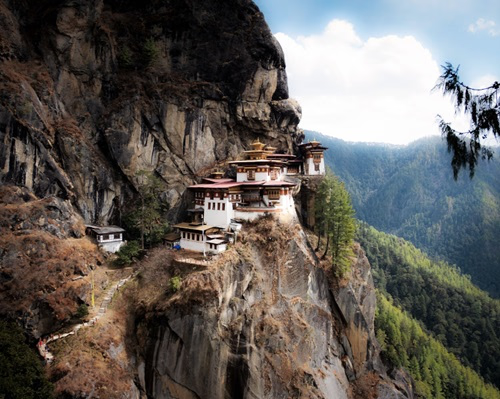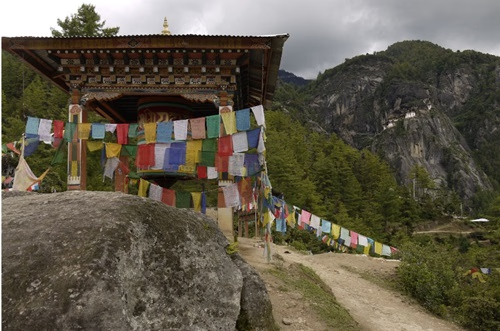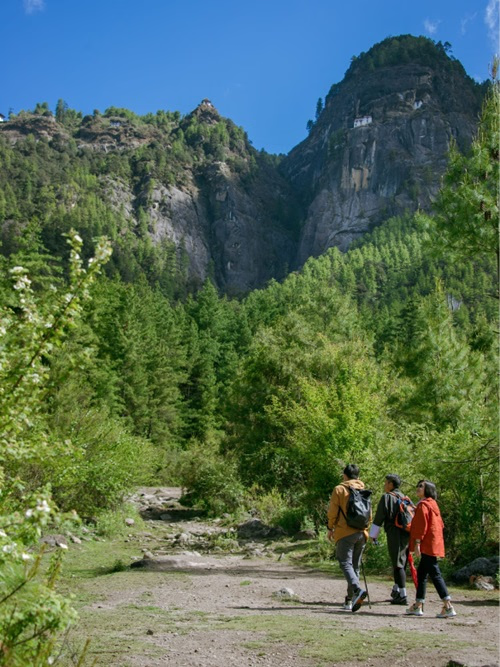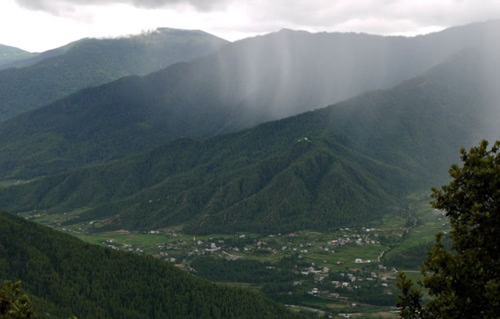
Geography Of The Tiger’s Nest In Bhutan
Taktsang Monastery, famously known as Tiger’s Nest in Bhutan or Paro Taktsang , is located in Paro district. The monastery is one of the most venerated places of pilgrimage in the Himalayan. Taktsang clings to the rock towering 800m (2,600feet) above the valley and is located 2,950m (9,678 feet) above the sea level. It takes about 2 to 3 hours (depending on your fitness level) to climb to the monastery from the base at the road of Ramthangkha, 12 kilometres from Paro town.
The Legend and History - Why Is Tt Called The Tiger’s Nest In Bhutan?
The legend of Taktsang (Tiger's nest) evolved form 747 AD when Guru Padmasmbhava (also known as Guru Rinpoche) chose a cave on a sheer rock face to meditate and, assuming a wrathful form, Guru Dorji Drolo, astride a tigress to subdue the evil spirits in the locality.
Legend has it that the tigress was actually Yeshi Tshogyal, a consort of Guru Rinpoche, who has transformed herself into a fearsome animal to subjugate spirits. It is also said that Yeshe Tshogyal transformed herself into a tigress to carry Guru Rinpoche on her back from Singye Dzong in Eastern Bhutan to Taktsang.
Guru Rinpoche then performed meditation at the very same site and emerged in eight incarnated forms (manifestations). Taktsang (Tiger’s Nest monastery) thus became one of the most important Buddhist sacred sites in the Himalayan Buddhist world.
At Taktsang, Guru Rinpoche revealed the Mandala of Pelchen Dorje Phurpa, and delivered sublime teachings to his disciples. He meditated in the cave for 3 years, 3 months, 3 weeks and 3 days before subjugating the malicious spirits, and concealed profound treasures for the benefit of sentient beings.
The Founding Of Paro Taktsang (Tiger’s Nest Monastery)

The first temple was built by Sonam Gyaltshen - a Nyingma Buddhist master - probably in 1508 at Taktsang Pelphug. In 1645, the whole site was offered to Zhabdrung Ngawang Namgyel, the founder of the nation state of Bhutan.
It was at Taktshang, during the Tibetan war of 1644/46, that Zhabdrung and his Nyingmapa teacher, Terton Rigdzin Nyingpo, first performed a ritual invoking Padmasambhava and the protective deities. Zhabdrung instructed Gyalsey Tenzin Rabgye, who subsequently became the fourth temporal ruler of Bhutan, to build the temple of the Eight Manifestations of the Guru there. The construction work began ion the 10th month of the Water Monkey Year (1692) and the two-storied temple was completed in 1694.
Between 1961 and 1965, the monastery was renovated by the 34th Je Khenpo (Chief Abbot), Shedrup Yoezer. Additions were made in 1861-65 and 1982-83, and then in 1992. On April 19, 1998, Taktsang was damaged in a tragic blaze. The current structure that exists was reconstructed in 2005.
The meticulous reconstruction to its full glory was spearheaded by the Fourth King of Bhutan, His Majesty Jigme Singye Wangchuck. During this fire, and the one in 1951, the speaking bronze statue of Guru Sungjonma is the only item that miraculously survived unscathed in both times.
There are currently four temples surrounding the main temple of Taktsang Lhakhang. All the buildings in the complex are interconnected by staircases with steps carved into the rock. The exterior of the complex has white-washed walls with gold painted roofs.
A prayer wheel is located in the courtyard and it is being rotated by residing monks at 4 a.m. daily to mark the beginning of a new day. The interior of the temples is also decorated with the finest details to reflect the finest Varjayana Buddhist tradition.
The Shrine Of Self-Speaking Guru
The story goes that the statue of the Guru was sculptured by Pentsa Deva at Punakha Thangdzong and taken to Taktsang. Upon arriving at the cliff across the sacred site of Taktsang, the monks were at a loss on how to carry the 12-feet statue across the canyon to the temple site.
The statue is supposed to have said: "Do not worry, for someone shall come to carry me to Taktsang!" Subsequently, the statue was miraculously transported and, thereafter, the place is known as the Temple of the Self-Speaking Statue of the Guru.
The shrine contains beautiful paintings of the eight manifestations of Guru Rinpoche and his twenty five chief disciples on the rock face. It also contains the throne used by Gyalse Tenzin Rabgye. All the sacred objects pertaining to the Eight Manifestations of Guru Rinpoche were built by famous Niwari artisans Pentsa Deva, Dharma Deva and Dharmashri.
What Is The Altitude Of Tiger’s Nest In Bhutan?
The altitude of Tiger's Nest in Bhutan is at 3,120 metres (10,240 feet) above sea level. Reaching the Tiger's Nest at this altitude is a journey that challenges both body and spirit. The trek to the monastery is a climb through a series of steep and winding paths, which can take around two to three hours to complete.
The high altitude means that the air is thinner, making the hike more strenuous, but also more rewarding. As you ascend, the temperature drops, and the vegetation changes, providing a constant reminder of the height you're achieving.
How Long Does It Take To Climb The Taktsang Monastery?

The climb to the monastery takes about 3 hours at a comfortable pace. Regular trekkers and gym enthusiasts can complete it in about 2 hours. The total walking distance is about 4 km one way with 700m in elevation gained. For those who are unable to climb, you can opt to rent a horse to ride up to the midway where a cafeteria is located.
However, descending the mountain has to be done on foot and renting a horse is not available. The cafeteria is the midpoint of the hike (from the starting point, it’s about 2km of steep climb), t where you will be able to catch some rest, refresh yourself, and fill up your tummy before continuing the hike. From the cafeteria, it takes approximately another 45 minutes to 1 hour to reach the Tiger’s Nest monastery.
You will then proceed another 2 km on a gentler slope to reach the second viewpoint, after which there will be concrete descending steps and you will be passing by a waterfall over a bridge, followed by the final ascending of 120 steps bringing one to the main entrance of Tiger’s Nest.
Along the way, you will walk past many colourful prayer flags that Bhutanese had strung up for the wind to bring compassion and blessings to all sentient beings. These colourful prayer flags called Lung Dhar, surface in five colours representing the five elements of nature.
New Trail Towards Taktsang Monastery
In 2020, during COVID-19 pandemic in Bhutan, while the nation’s border was closed for international tourism, a new trail towards Taktsang was developed. The hiking time has now shortened compared to the old trail. There is also a separate path for humans and horses in the new trail, contrary to the old path where both share the same walkway.
More benches, canopies and resting places have also been built along the way. This means that you can take a break anytime when you want to catch your breath. You can enjoy your walk up at your own pace and take in the magnificent views of the Himalayan mountains along the way.
7 Tips for Visiting The Tiger’s Nest In Bhutan
-
Start early if you want to avoid the crowd and the heat.
-
Wear a pair of good walking shoes to protect your ankles, bring a hat and sunscreen.
-
You can also rent a walking stick at the base of Tiger’s Nest if required.
-
Stay hydrated and take your time. The ascent gains an elevation of 700 m, although it is below an altitude of 3000m, it is wise to pace yourself to avoid overexertion and result in altitude sickness.
-
Regulate your breathing to avoid panting. You will expend more energy if you pant.
-
Bring a warm jacket as your body cools down pretty fast when you are visiting the temple.
-
Bring some snacks to chew on once you reach the peak to restore your energy and keep warm for the return journey.
You are required to deposit all your electronic and photography equipment with the sentry before entering the complex.
Photography is prohibited inside the temple as with all other temples and monasteries in Bhutan. You are required to remove your shoes and headgears upon entering Tiger’s Nest monasteries. Take plenty of photos to keep the memories of your spiritual journey in Bhutan.
The Taktsang Monastery View

Royalties & Celebrities Who Visited Tiger’s Nest In Bhutan
Over the years, many prominent people from all over the world have visited this majestic icon of Bhutan. Some of these personalities include royals from the House of Windsor like Prince Charles who stopped to do a painting of the Tiger’s Nest near the cafeteria in 1998.
The Duke and Duchess of Cambridge, Prince William and Kate Middleton also visited Bhutan on the invitation of the Fifth King of Bhutan, His Majesty Jigme Khesar Namgyel Wangchuck in 2016.
From Japan - Princess Mako and Crown Prince Akishino also visited Tiger’s Nest in 2018 and 2019 respectively. Other royalties included the royal families from Thailand, Norway and many more Europeans royalties.
From Asia - Jet Li meditated at Tiger’s Nest in 2017 and actor Tony Leung, famed for holding his wedding in Bhutan back in 2008, is also rumoured to be a frequent visitor of Bhutan and Tiger’s Nest.
From Hollywood - Cameron Diaz, Michael J. Fox, Drew Berrymore, Demi Moore and Leonardo DiCaprio have all visited Bhutan and the Tiger’s Nest throughout the years.
Perhaps one show that brought Bhutan to the fore for Hollywood would be “Little Buddha” where Keanu Reeve plays the role of Siddhartha in this 1993 movie. You may also have spotted a black and white photo of Tiger’s Nest in Guy Richie’s most recent movie “The Gentlemen''.
Look out for the photo of Tiger’s Nest in Charlie Hunman’s kitchen when he was negotiating with Hugh Grant. In fact, a photo of Tiger’s Nest has been spotted in quite a few movie sets as a little background detail.
Entrance Fee In Taktsang Monastery
After the revision of visa policy of Bhutan in July 2022, it was decided that an entrance fee of 2,000 Nu will be levied for all visitors to Taktsang Monastery from September 23, 2022.
Children below the ages of 18 will be charged only 50% of the fees and children ages 5 and below will be exempted from the payment of fees. If you book your trip to Bhutan with a tour operator like Druk Asia, the entrance fee will be included in the tour package cost.
Entry Restrictions In The Taktsang Monastery
Under the same revision, there will be special dates on the Bhutanese lunar calendar whereby only Bhutanese will be allowed to visit Taktsang. The six auspicious dates in the Bhutanese calendar are:
-
5th of the 1st month (Chotrul Duchen)
-
10th day of the 3rd month (Zhabdrung Kuchoe)
-
15th day of the 4th month (Lord Buddha Parinirvana, Vesak Day)
-
4th day of the 6th month (first sermon of Lord Buddha)
-
22nd day of the 9th month (Descending day of Lord Buddha)
-
10th day of the 5th month (Birth anniversary of Guru Rinpoche)
Conclusion About The Tiger’s Nest In Bhutan
The Tiger’s Nest Monastery, perched on a cliffside, is one of Bhutan’s most iconic landmarks. Its unique location, spiritual significance, and picturesque scenery make it a compelling destination for travellers.
Visiting the Tiger's Nest is not only a physical journey but also a chance to connect with Bhutan's rich cultural heritage and natural beauty.
Ready to explore the Tiger's Nest and experience the magic of Bhutan? Contact Druk Asia to plan your unforgettable adventure to this remarkable destination.
Frequently Asked Questions About The Tiger’s Nest In Bhutan
What Is The Best Time Of Year To Visit The Tiger's Nest Monastery?
The best time to visit is during the spring and autumn months (March to May and September to November) when the weather is mild and the skies are clear. Winter can be cold and snowy, while the summer months can be rainy.
Are There Any Facilities Or Amenities At The Tiger's Nest In Bhutan?
The monastery itself is not equipped with modern facilities, but there are rest stops and small tea houses along the hiking trail where visitors can rest, buy snacks, and use basic restroom facilities.
What Should I Pack For The Trek To The Tiger's Nest In Bhutan?
Essential items to pack include comfortable hiking shoes, layered clothing, a hat, sunscreen, water, snacks, a rain jacket, and a camera. A walking stick can also be helpful for the trek.
Are There Any Places To Rest Or Eat Along The Way To The Tiger’s Nest In Bhutan?
Yes, there are rest stops and a cafeteria halfway up the trail where visitors can rest, enjoy refreshments, and take in the scenic views before continuing their ascent.
Can I Take Photographs Inside The Tiger's Nest In Bhutan?
No, photography is not allowed inside the monastery to preserve its sanctity and protect the artefacts. However, you can take photos of the exterior and the beautiful surrounding landscape.
How Physically Challenging Is The Trek To The Tiger's Nest In Bhutan?
The trek is moderately challenging, with steep and uneven paths. It requires a reasonable level of fitness, but you may also hire a horse to bring you up to the halfway point to enjoy the view should you have difficulty hiking. However, many non-hikers managed to hike all the way up to the Tiger’s Nest while pacing well and taking their time.
